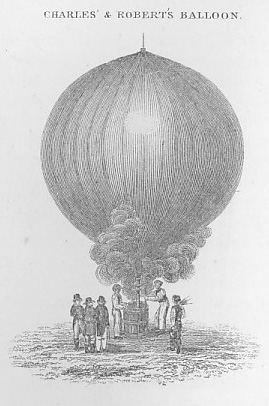Ascent of the First Balloon: MM. Robert and Charles
The news of the experiment at Annonay rapidly spread over Europe, and at Paris attracted so much attention that M. Faujas de Saint-Fond, a naturalist, set on foot a subscription for paying the expense of repeating the experiment.
The balloon was constructed by two brothers of the name of Robert, under the superintendence of M. Charles, professor of natural philosophy in Paris, and afterwards a member of the Academy of Sciences. It had at first been suggested to copy the process of Montgolfier, but Charles proposed the application of hydrogen gas, which was adopted. The filling of the balloon, which was made of thin silk varnished with a solution of elastic gum, and was about 13 feet in diameter, was commenced on August 23, 1783, in the Place des Victoires. The hydrogen gas obtained by the action of dilute sulphuric acid upon filings, and was introduced through leader pipes; but as the gas was not passed through cold water, great difficulty was experienced in filling the balloon completely; and altogether about 500 lb of sulphuric acid and twice that amount of iron filings were used. Bulletins were issued daily of the progress of the inflation; and the crowd was so great that on the 26th the balloon was moved to the Champ de Mars, a distance of 2 miles. This was done secretly, in the middle of the night, to avoid the crowd; and the appearance of the balloon being thus removed, preceded by lighted torches and escorted by a detachment of soldiers, is described as having been very remarkable. On the next day, August 27, and immense concourse of people covered the Champ de Mars, and every spot from which a view could be obtained was crowded. About five o'clock a cannon was discharged as the signal for the ascent, and the balloon when liberated rose to the height of about 3000 feet with great rapidity. A shower of rain which began to fall directly after the balloon had left the earth in no way checked its progress; and the excitement as so great, that thousands of well-dressed spectators, many of them ladies, stood exposed, watching it intently the whole time it was in sight, and were drenched to the skin. The balloon, after remaining in the air for about three quarters of an hour, fell in a field near Gonesse, about 15 miles off, and terrified the peasantry so much that it was torn into shreds by them. Hydrogen gas was at this time known by the name of inflammable air; and balloons inflated with gas have ever since been called by the people air-balloons, the kind invented by the Montgolfiers being designated fire-balloons. French writers have also very frequently styled them after their inventors, Charlieres and Montgolfieres.
Read the rest of this article:
Aeronautics - Table of Contents
